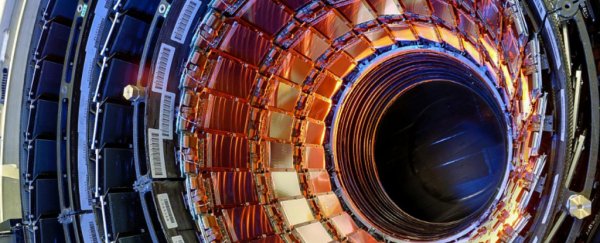Martin Rees, a well-respected British cosmologist, has made a pretty bold statement when it comes to particle accelerators: there's a small, but real possibility of disaster.
Particle accelerators, like the Large Hadron Collider, shoot particles at incredibly high speeds, smash them together, and observe the fallout.
These high speed collisions have helped us discover lots of new particles, but according to Rees, this isn't without its risks.
In a new book, called On The Future: Prospects for Humanity, he gives some pretty bleak outlooks.
"Maybe a black hole could form, and then suck in everything around it," he writes, as Sarah Knapton reports over at the Telegraph. "The second scary possibility is that the quarks would reassemble themselves into compressed objects called strangelets."
"That in itself would be harmless. However under some hypotheses a strangelet could, by contagion, convert anything else it encounters into a new form of matter, transforming the entire earth in a hyperdense sphere about one hundred metres across."
That's approximately 330 feet, or around the length of a soccer field.
And that's not all. The third way that particle accelerators could destroy the Earth, according to Reese, is by a "catastrophe that engulfs space itself".
"Empty space - what physicists call the vacuum - is more than just nothingness. It is the arena for everything that happens. It has, latent in it, all the forces and particles that govern the physical world. The present vacuum could be fragile and unstable."
"Some have speculated that the concentrated energy created when particles crash together could trigger a 'phase transition' that would rip the fabric of space. This would be a cosmic calamity not just a terrestrial one."
Sounds frankly terrifying. But should we really be worried? Surely the smart people at the LHC can clear this up.
"The LHC Safety Assessment Group (LSAG) reaffirms and extends the conclusions of the 2003 report that LHC collisions present no danger and that there are no reasons for concern," CERN writes on their website.
"Whatever the LHC will do, nature has already done many times over during the lifetime of the Earth and other astronomical bodies."
And this is an important point – cosmic rays are basically natural versions of what the LHC and other particle accelerators are doing. And these rays hit Earth constantly.
The team behind the LHC have an answer for strangelets as well.
"Could strangelets coalesce with ordinary matter and change it to strange matter? This question was first raised before the start up of the Relativistic Heavy Ion Collider, RHIC, in 2000 in the United States," they explain.
"A study at the time showed that there was no cause for concern, and RHIC has now run for eight years, searching for strangelets without detecting any."
Even the late, great Stephen Hawking gave his blessing to the particle accelerator:
"The world will not come to an end when the LHC turns on. The LHC is absolutely safe. … Collisions releasing greater energy occur millions of times a day in the earth's atmosphere and nothing terrible happens," said Hawking.
In a way, Rees is correct. We're not 100 percent sure, and might never be. But as he explains, many scientific advances can have risks, but that's not to say we need to stop entirely.
"Innovation is often hazardous, but if we don't forgo risks we may forgo benefits," he writes in On The Future.
"Nevertheless, physicists should be circumspect about carrying out experiments that generate conditions with no precedent, even in the cosmos," Rees writes.
"Many of us are inclined to dismiss these risks as science fiction, but give the stakes they could not be ignored, even if deemed highly improbable."
We'll leave that gargantuan task to the particle physicists.
